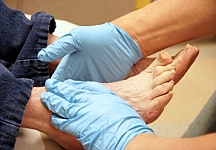



Diabetic Foot Care
According to the American Diabetes Association, about 15.7 million people (5.9 percent of the United States population) have diabetes. Nervous system damage (also called neuropathy) affects about 60 to 70 percent of people with diabetes and is a major complication that may cause diabetics to lose feeling in their feet or hands.
Foot problems are a big risk in diabetics. Diabetics must constantly monitor their feet or face severe consequences, including amputation.
With a diabetic foot, a wound as small as a blister from wearing a shoe that's too tight can cause a lot of damage. Diabetes decreases blood flow, so injuries are slow to heal. When your wound is not healing, it's at risk for infection. As a diabetic, your infections spread quickly. If you have diabetes, you should inspect your feet every day. Look for puncture wounds, bruises, pressure areas, redness, warmth, blisters, ulcers, scratches, cuts and nail problems. Get someone to help you, or use a mirror.
Diabetes and your feet:
Did you know that diabetics are more prone to foot infections and have an increased chance of lower extremity amputation during their lifetime?
Why do diabetics have more foot problems?
There are two main reasons why diabetics have complications with their feet.
- Nerve damage (neuropathy): Long standing diabetes often (almost 2/3 of diabetics) leads to diminished nerve function, often causing pain and tingling. However, severe nerve damage causes lack of sensation leading to cuts, scratches, and even broken bones in the foot. These problems can go unnoticed by a diabetic, leading to devastating events, including amputation.
- Circulation problems: Diabetes often causes a decrease in blood flow to the extremities. This can cause cuts and scratches not to heal properly, leading to infection and sometimes amputation. A foot with circulation problems is at a much higher risk for infection and amputation.
Some good news:
Most diabetic complications are avoidable. By visiting your primary doctor regularly, controlling your weight and exercising (and quitting smoking), you can greatly decrease your chance for the complications listed above. You should also visit your podiatrist regularly, as recommended for all diabetics by the ADA (American Diabetes Association).
Common problems such as corns, calluses, and ingrown toenails can lead to foot infections in a diabetic. Diabetics should have these problems cared for by their podiatrist. We will fully examine your foot and the status of your circulation and nerves in our office on your first visit. We will also provide you with diabetic education and literature on how to prevent these complications.
Here's some basic advice for taking care of your feet:
- Always keep your feet warm.
- Don't get your feet wet in snow or rain.
- Don't put your feet on radiators or in front of the fireplace.
- Don't smoke or sit cross-legged. Both decrease blood supply to your feet.
- Don't soak your feet.
- Don't use antiseptic solutions, drugstore medications, heating pads or sharp instruments on your feet.
- Trim your toenails straight across. Avoid cutting the corners. Use a nail file or emery board. If you find an ingrown toenail, contact our office.
- Use quality lotion to keep the skin of your feet soft and moist, but don't put any lotion between your toes.
- Wash your feet every day with mild soap and warm water.
- Wear loose socks to bed.
- Wear warm socks and shoes in winter.
- When drying your feet, pat each foot with a towel and be careful between your toes.
- Buy shoes that are comfortable without a "breaking in" period. Check how your shoe fits in width, length, back, bottom of heel, and sole. Avoid pointed-toe styles and high heels. Try to get shoes made with leather upper material and deep toe boxes. Wear new shoes for only two hours or less at a time. Don't wear the same pair everyday. Inspect the inside of each shoe before putting it on. Don't lace your shoes too tightly or loosely.
- Choose socks and stockings carefully. Wear clean, dry socks every day. Avoid socks with holes or wrinkles. Thin cotton socks are more absorbent for summer wear. Square-toes socks will not squeeze your toes. Avoid stockings with elastic tops.
When your feet become numb, they are at risk for becoming deformed. One way this happens is through ulcers. Open sores may become infected. Another way is the bone condition Charcot (pronounced "sharko") foot. This is one of the most serious foot problems you can face. It warps the shape of your foot when your bones fracture and disintegrate, and yet you continue to walk on it because it doesn't hurt. Diabetic foot ulcers and early phases of Charcot fractures can be treated with a total contact cast.
The shape of your foot molds the cast. It lets your ulcer heal by distributing weight and relieving pressure. If you have Charcot foot, the cast controls your foot's movement and supports its contours if you don't put any weight on it. To use a total contact cast, you need good blood flow in your foot. The cast is changed every week or two until your foot heals. A custom-walking boot is another way to treat your Charcot foot. It supports the foot until all the swelling goes down, which can take as long as a year. You should keep from putting your weight on the Charcot foot. Surgery is considered if your deformity is too severe for a brace or shoe.